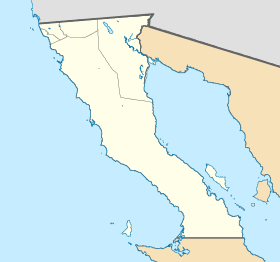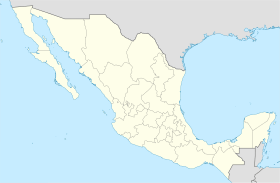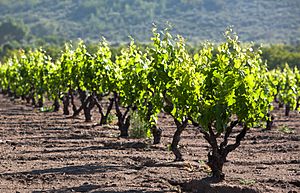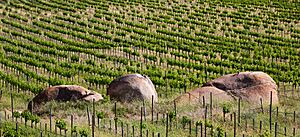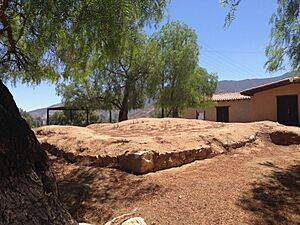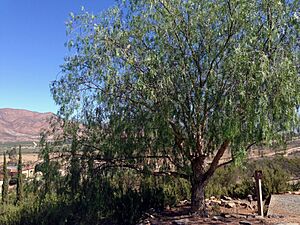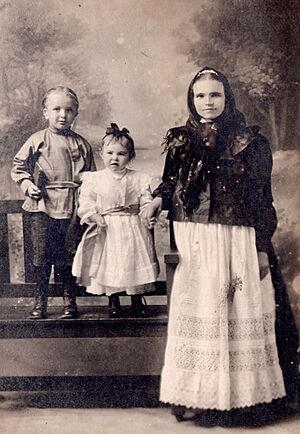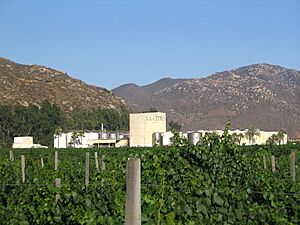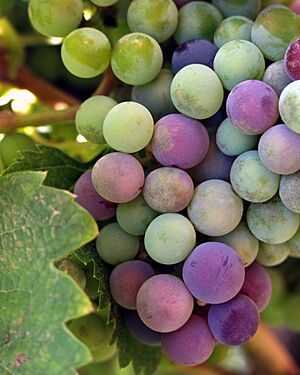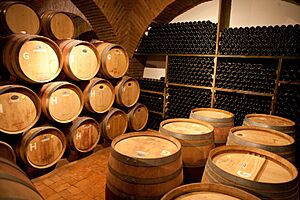Valle de Guadalupe facts for kids
Quick facts for kids
Valle de Guadalupe
|
|
|---|---|
|
Town
|
|
| Valle de Guadalupe | |
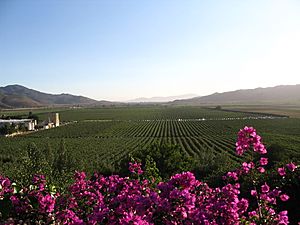
Valle de Guadalupe
|
|
| Country | |
| State | |
| Municipality | |
| Elevation | 1,129 ft (344 m) |
| Population
(2010)
|
|
| • Total | 5,859 |
| Time zone | UTC-8 (Northwest US Pacific) |
| • Summer (DST) | UTC-7 (Northwest) |
The Valle de Guadalupe (Guadalupe Valley) is a special farming area in Ensenada Municipality, Baja California, Mexico. It's famous for making about 70 percent of all Mexican wine. Lately, it has also become a popular place for tourists who want to try local wines and delicious Baja Med cuisine.
The Valle de Guadalupe is located about 20 kilometers (12 miles) north of the City of Ensenada. It's also about 113 kilometers (70 miles) southeast of the border crossing from San Diego to Tijuana. In 2010, about 5,859 people lived in the valley.
Contents
Landscape and Weather
The Valle de Guadalupe covers a large area, about 66,353 hectares (163,962 acres), and is surrounded by hills made of granite. A riverbed called the Guadalupe Arroyo runs under the valley floor. This makes the soil sandy but good for growing things. Water only appears on the surface of the river during heavy rains.
The valley gently slopes from the northeast to the southwest. Its average height is 344 meters (1,129 feet) above sea level. The edges of the valley have reddish soil that has washed down from the nearby hills. You can find Chaparral plants on the rocky slopes and live oak trees in wet, narrow canyons. Agave and cactus plants grow all over the region, and small groups of pine trees are on the highest hills.
The valley has a Mediterranean climate. This means it has cool, rainy winters and dry, warm summers. Ocean breezes help keep the temperature mild. The average temperature is about 5°C (41°F) in winter and 30°C (86°F) in summer.
Economy and Tourism
The Valle de Guadalupe is unique in Mexico because it's so good for growing grapes used to make wine. This makes grapes the most valuable crop here. The mild weather allows winemakers to grow many different types of grapes, like Malbec, Sauvignon Blanc, and Tempranillo. Red grapes used for Bordeaux wine are very common. Other crops grown in the valley include olive and orange trees, European vegetables, herbs, fruits, and honey. Farmers also raise cattle.
The number of wineries in the area has grown a lot. In 1999, there were only 6 wineries, but by 2005, there were 25. By 2023, the valley had 150 wineries, 92 hotels, and even 12 taco stands!
Tourism is a big part of the economy, especially for wine and Baja Med cuisine. This brings in about US$180 million each year to Baja California. Because of this, festivals like the Valle de Guadalupe Vendimia Wine Harvest Festival have become very popular.
History of the Valley
Early People
Scientists believe people have lived in the Valle de Guadalupe for a very long time, possibly for 7,000 to 10,000 years. The Kumeyaay (Kumiai) people called this area Ojá cuñurr, which means "painted cave." This name came from a large rock with colorful drawings, which was likely a place for important gatherings.
The Kumeyaay and Kiliwa lived in small villages called rancherías in the valley. The biggest one was Rincón de los Encinos, named after a group of oak trees. In 1885, over 330 native people lived in the valley. Today, some Kumeyaay people still live in the region, including at San Antonio Necua.
The Last Mission
The valley was home to the very last Dominican mission in Baja California. It was built in 1834 by Dominican missionary Father Félix Caballero. This mission, called Misión de Nuestra Señora de Guadalupe del Norte, was meant to be a main center for the area.
The mission was built in a square shape. It had a church and a home for the priest. People who came with Father Caballero lived in a ranch house nearby, which still exists today. The mission had almost 5,000 cattle, and they grew wheat, vegetables, grapes, and fruit trees.
However, this mission only lasted until 1840. A local leader named Jatñil led a rebellion because his people were being forced to change their beliefs. Father Caballero left this mission and three others, and he died soon after.
Land Changes and New Settlers
After the mission closed, the Mexican government allowed private people to settle on the land. In the 1840s, Juan Bandini was given the Rancho ex-Misión de Guadalupe, though this was a bit controversial.
Later, during the Mexican-American War, a Mexican leader named José Matías Moreno II tried to fight against U.S. forces in Baja California. He was arrested and held prisoner until the war ended.
In 1858, during a Gold Rush in Baja California, the Mexican government sold what they called "unoccupied" lands in the Valle de Guadalupe. They divided the valley into several large ranches, even though native people lived there.
In 1861, José Matías Moreno II returned to the valley to protect Mexico's interests. He made his headquarters at Rancho ex-Misíon de Guadalupe. He worked to stop people from other countries from trying to take over Lower California. He also made sure that foreigners could not own land close to the border.
Moreno was very loyal to Mexico, which allowed him to buy Bandini's former ranches. In 1863, he officially owned Rancho ex-Misíon de Guadalupe. He and his wife, Prudenciana Vallejo López de Moreno, turned it into a working ranch.
Russian Colony
The Rancho ex-Misión de Guadalupe was sold several times. In 1905, it was bought by a group of Russian Molokans. These were religious people who had left their home country to escape unfair treatment. They formed a farming group and settled in four colonies near Ensenada. The main colony in Guadalupe covered about 5,266 hectares (13,013 acres).
Between 1905 and 1911, about 104 families moved to Guadalupe. They built a village with adobe houses that looked like Mexican homes but had steep, shingled roofs like Russian ones. Molokans worshipped in simple buildings and believed in being sober, peaceful, and working together.
By 1928, wheat was the main crop they sold, but they also had fruit orchards, vegetable gardens, and vineyards.
Land Reform and Modern Times
The Magonista rebellion of 1911, an early part of the Mexican Revolution, caused some Russian families to leave the valley. More Russians left when the Mexican government started to share large private lands as community land. This was part of a plan called the ejido system. In 1937, the government gave 2,920 hectares (7,215 acres) next to the Molokan colony to 58 ejidatários (farmers who received communal land). This new settlement was called Ejido El Porvenir.
In the late 1950s, a new highway (Mexico Highway 3) brought more people to the valley. Some people, called paracaidistas (squatters), claimed parts of the valley for themselves. They formed the town of Francisco Zarco near the old mission site. By the early 1990s, only one family of "pure Russians" lived in the valley. However, some descendants of the original Russian colony married into local Mexican families and still live in the area.
Vineyards and Wineries
The Valle de Guadalupe is perfect for making wine because of its elevation and special weather. In 2023, there were 150 wineries along the valley's Ruta del Vino (Wine Route). Together, they produce 70 percent of all of Mexico's wines.
Since the 1990s, the Association of Winemakers of Baja California holds the Fiestas de la Vendimia (Wine Harvest Festival) every August. This celebration includes wine tasting, concerts, and chances to try local cuisine and Mexican wines. There's also another festival in October.
You can go wine tasting all year round. Many wineries have fancy restaurants and tasting rooms for tourists, especially those from the United States. Cruise ships that stop in Ensenada often include a winery tour.
Here are some of the many wineries in the Valle de Guadalupe:
- L.A. Cetto
- Monte Xanic
- Adobe Guadalupe
- Las Nubes
- Barón Balché
- Bodega Santo Thomás
- El Cielo
- Alximia Vinícola
- Trevista
- Vena Cava
Delicious Food Scene
Many wineries in the Valle de Guadalupe have "campestre" (countryside) restaurants. These places serve "farm-to-table" food, meaning ingredients are fresh and local. Famous chefs have opened restaurants here, like Finca de Altozano by Javier Plascencia and Drew Deckman's Deckman's en el Mogor. The area is a hub for Baja Med cuisine, which mixes Mexican, Mediterranean, and Asian flavors. You can also find traditional places like La Cocina de Doña Esthela, which are very popular.
Places to Stay
The Valle de Guadalupe has many unique hotels. Some examples include chef Javier Plascencia's Finca la Divina, Bruma (an eco-resort with a winery), and Encuentro Guadalupe. Encuentro Guadalupe has 20 eco-friendly rooms that blend right into the natural landscape.
See also
 In Spanish: Valle de Guadalupe (Baja California) para niños
In Spanish: Valle de Guadalupe (Baja California) para niños


